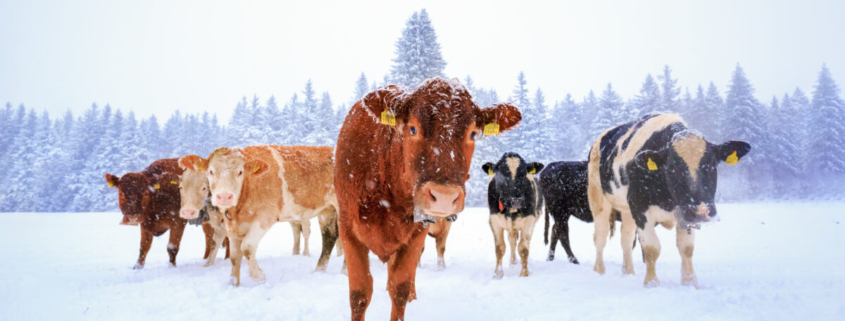How to care for livestock this winter
When bitter cold days are in the forecast, livestock and pet owners need to be vigilant about the care they give to outdoor animals. While many hobby farm animals in Iowa are well acclimated to lower temperatures, a few basic considerations can keep livestock healthy and comfortable throughout the winter months.
Amy Powell, a 4-H specialist with Iowa State University Extension, says a key part of managing any animal’s health is establishing a good relationship with a veterinarian. While general resources can provide a good starting point, veterinarians can provide more specific recommendations based on an individual animal’s needs.
“It’s always important to have a relationship with a veterinarian, whether you have a cat or a pig,” Powell says.
Another important consideration for any animal is water availability. “The biggest concern to keep in mind is making sure your water doesn’t freeze,” she notes. “However, sometimes animals won’t drink water that’s too warm, so it’s important to find that balance.
“An electric water heater can be a good solution; you just want to make sure it doesn’t get too hot or short out,” she adds.
For more specific guidelines, including species-specific daily water consumption ranges, visit the ISU Extension publication Watering Systems for Grazing Livestock.
Meet nutritional needs
Nutrition is also important when temperatures drop. “At low temperatures, livestock animals are using a lot more energy to keep warm,” Powell says. “It’s important to up nutrition availability, whether that’s through higher-quality hay or giving them more grain, or whatever that animal eats.”
As far as exposure to the elements, many livestock animals in Iowa are well acclimated to the cold and can tolerate low temperatures so long as they are provided with adequate water and nutrition.
“Since most animals are outside all the time, they have a thick winter coat,” she explains. “As long as they have been outside and are acclimated to being outside, they can survive in pretty cold temperatures.”
For additional shelter from the elements, Powell recommends providing a windbreak for pasture animals.
Caring for young
Despite these adaptations, it’s important to provide additional consideration for young animals, which are smaller and more susceptible to temperature injury.
“If an animal is getting ready to hatch or give birth, then you want to make sure that the birth or hatching takes place somewhere warm,” Powell advises. “If temperatures are at or below freezing, and the mother doesn’t get the baby cleaned off quickly enough, the baby can freeze to death.”
When determining if livestock animals are experiencing discomfort from the cold, Powell recommends observing their behavior.
“When chickens and pigs get cold, they will huddle together. If you see a big pile of chickens or pigs, they may be too cold,” she says. “Sheep and cattle, and especially young lambs and calves, will shiver and hunch up if they get too cold.”
If concerned, take their body temperature to check if they’re going into hypothermia. “If an animal is experiencing temperature discomfort, the first thing you want to do is contact your vet,” she says. “Then, you want to warm them up slowly. Don’t submerge them in hot water, because if you heat them up too quickly, that can lead to other issues.”
Online resources can help take nip out of cold
Adequate preparation can reduce the impact of cold temperatures on farm animals. These university publications provide guidance on management practices that help reduce the impact of cold stress:
- ISU Extension and Outreach: Caring for Cow Herds During Cold Weather
- Michigan State Extension: Winter Management Tips for Goats and Winter Management Tips for Sheep
- Penn State Extension: Cold Temperature Management for Pigs
- University of Minnesota Extension: Caring for Chickens in Cold Weather







Leave a Reply
Want to join the discussion?Feel free to contribute!